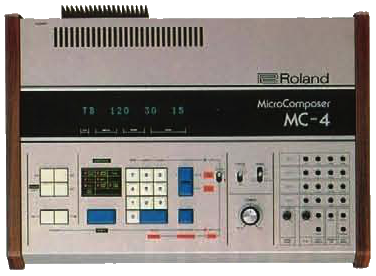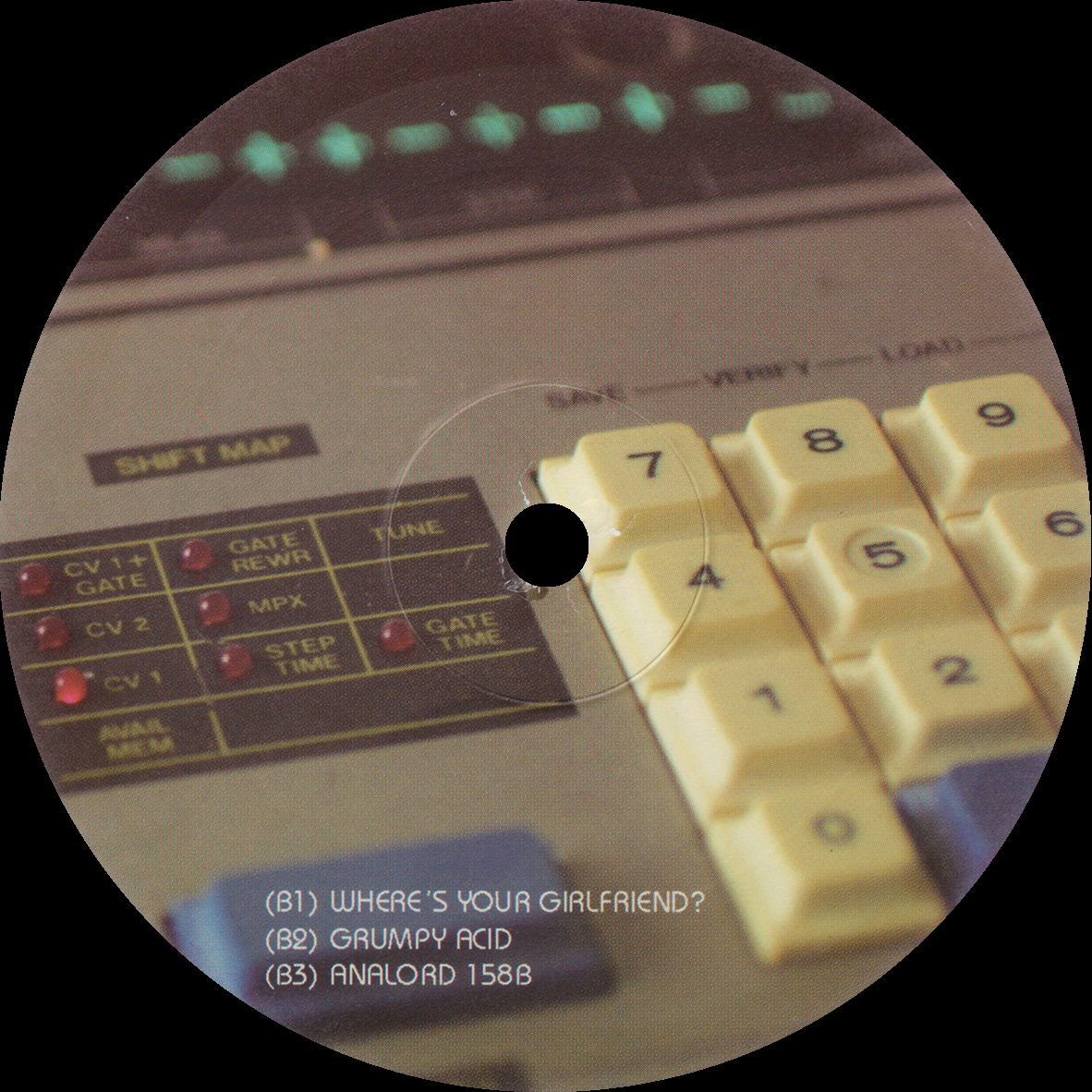MC-4
MC-4 tech specs

Roland MC-4
- Released: 1981[1][2]
- Price: £1,395[3]
- Company: Roland
- Type: Digital sequencer
- Clock resolution: 1-240 PPQN
- Control: 1V/Oct CV & V-trig gate
- Synchronisation: DIN sync; tape sync
- Patch jacks: 3.5 mm TS phone jacks
- CPU: 8-bit NEC μPD780-1[4]
- RAM: 16 KB[4]
- Storage: Cassette tape (optional)
- Display: 16×1 character VFD
The MC-4 (short for MicroComposer) was a digital sequencer released by Roland in 1981. It was the successor to the MC-8.
Judging by contemporary brochures, it seems to have been designed to work with the System-100M.
As with the MC-8, you could play notes into it easily enough with the CV and gate inputs, but then editing those notes afterwards involved the cumbersome calculator-style number pad.
Whereas the MC-8 had eight pairs of CV (for pitch) and gate outputs, and six multiplex outputs, the MC-4 had four sets of CV 1 (pitch), CV 2 (velocity), gate, and multiplex outputs. In other words, it sequences four tracks instead of eight, but with more expressivity.
With such granular control still, it's up to you what to use the outputs for. For example, you could forego one channel's velocity, and instead use its two CV outputs for a duophonic or paraphonic part that can play two separate pitches at once, shared through a single VCA.
This is likely the first machine with DIN sync built in as standard — in either direction, no less — although towards the end of the MC-8's production run, an official DIN sync output modification became available.[5] DIN sync is essentially a simplified version of tape sync, skipping the logical ANDing and modulation of the run/stop gate and clock pulse signals.
MC-4B
MC-4B tech specs
- Company: Roland
- Clearance price: £365[6]
- Type: Digital sequencer
- Clock resolution: 1-240 PPQN
- Control: 1V/Oct CV & V-trig gate
- Synchronisation: DIN sync; tape sync
- CPU: 8-bit NEC μPD780-1[4]
- RAM: 48 KB[4]
- Storage: Cassette tape (bring your own tape recorder)
- Display: 16×1 character VFD
The MC-4B tripled the RAM to a spacious 48 KB.
Accessories
- MTR-100 Cassette tape recorder
- OP-8 CV interface
Quotes

Analord 01 B-side
They have missed off one basic function for me — the six multiplex pulses which can be routed to control any channel. We don't write rhythms and music sequences in realtime, we do it with a series of machine code style instructions.
— Richard Burgess, Landscape, 1981[7]
There are certain things about the newer Roland MC-4 which are better than the original MC-8, and there are certain things that aren't so good. We're contemplating getting an MC-4 soon for specific jobs, because it'll be faster.
— Martin Rushent, producing The Human League, 1982[8]
We've done one track where the MC-4 controlled the three VCOs on the ARP 2600 for a chordal brass sound; that's worked really well. It interfaces with the ARP and the RSF module perfectly. The MC-4 is a great compositional tool, though. There's a new song called "The Meaning of Love" which, when Martin presented it, was very basic, so we worked out a bassline on the MC-4, but while they were playing along with it Martin did this little riff, so we just edited a space in the MC-4's memory and inserted it. This means that you can work out the structure of a song and get it exactly right without having to put it down on to tape, and then you don't have to mess around with tape editing at a later date.
— Daniel Miller, producing Depeche Mode, 1982[9]
We're using an MC-4 MicroComposer rather than the MC-8 now, mainly to play other lines which are more guitar-orientated like pitched rhythm parts. It's essentially faster, and easier to transpose and copy parts. The cassette interface is good too, and because of that it makes it possible if you want to use it live. It's four channels as against eight, which limits you to some extent, but overall it is better. Also, you can plug things in the wall elsewhere and it doesn't throw a fit — it's more stable.
— Chris Heaton, Landscape, 1982[10]
LinnDrums and MC-4s gave us the completely programmable tunes and rhythms we'd always wanted in the early Human League. That was vital, because we never rehearse, we just go straight onto tape, and the tunes are also composed on tape.
— Martyn Ware, The Human League, 1983[11]
We used [an MC-4] extensively with the OP-8 interface for our JP-8. It's very laborious, entering in each note in that code form. To a certain extent, that's the same problem that afflicts the MPL on the Fairlight — that's a programming language similar in format to the MC-4's operating system. It's not really user-friendly at all. If you've got the odd three or four weeks to spare, you might be able to program a song. It's actually more flexible than Page R in the final analysis. So what? More flexible if you've got that amount of time, which you haven't if you're a professional musician.
— Martyn Ware, Heaven 17, 1984[12]
If a snare drum is out of time, with a CV and gate system it's consistently out of time, and you can pull it back in line quite easily, whereas with MIDI it shifts in time, and everything does that all the time. It wasn't that I was actually worried about the timing aspect of it, but I was interested to see what difference it made.
— Vince Clarke, Erasure, 1991[13]
Using the MC-4, you can't really use chords, everything had to be monophonic lines. I think also I'm a bit anti-pad. It's too easy really, if you use pad chords all the time. Also, with individual melody lines you can hear the different sounds in the lines properly.
— Vince Clarke, Erasure, 1991[13]
I did sell my MC-4. They're like making tracks on a taxi meter, top. Loved the number pad entry. The manual, as we've discussed before, is nuts. Not looked at it in years. Would like to again now I'm thinking about it, but the manual reminded me of programming assembly language at college on Nascom computers and programming the machine.
— Richard D. James (Aphex Twin), 2014[14]
Notable users
- Aphex Twin[14] (in the appropriately titled "MC-4 Acid")
- The Assembly[15][16]
- Suzanne Ciani[17][18]
- Depeche Mode[9][19]
- Erasure[20][13][21][22]
- Fad Gadget[23]
- Heaven 17[11][12]
- The Human League[24][11][25]
- Landscape[10][23][26]
- Tears for Fears[26]
- Isao Tomita[27]
- Yazoo[15][20]
Technical notes
The MC-4's CPU board uses an 8-bit NEC μPD780 microprocessor, and eight MB8116N or M5K4116 (MK4116 clones by Fujitsu and Mitsubishi respectively) DRAM ICs for 16 KB of RAM. The MC-4B's additional RAM board adds another sixteen of these DRAM ICs.[4]
References
- "Roland Keyboard Catalogue, Volume 2" Roland, Oct 1981
- "Company Report - Roland" One Two Testing, Mar 1985, pp. 81—82
- "Future Music" Future Music (Vendor), Electronics & Music Maker, Mar 1982, p. 67
- "MC-4 service notes" Roland, Jan 1982
- "Roland MC-8 MicroComposer (Retro)" Chris Carter, Sound On Sound, Mar 1997
- "Soho Soundhouse" Soho Soundhouse (Vendor), Electronics & Music Maker, Feb 1986, p. 70
- "Landscape Explored" Mike Beecher, Electronics & Music Maker, Nov 1981, pp. 6—10
- "Human League in the Studio" Tony Bacon, Electronics & Music Maker, Apr 1982, pp. 4—8
- "Depeche Mode" Steve Howell, Electronics & Music Maker, May 1982, pp. 40—41
- "Landscape On The Horizon" Tony Bacon, Music UK, Aug 1982, pp. 18—23
- "Heaven 17" Mark Jenkins, Electronic Soundmaker & Computer Music, Nov 1983, pp. 16—18
- "Heaven's Gate" Tony Bacon, One Two Testing, Aug 1984, pp. 16—88
- "Vince Clarke" Paul Ireson, Sound On Sound, Dec 1991, pp. 52—56
- "Aphex Twin SYROBONKERS! Interview Part 1" Dave Noyze, 2014
- "Downstairs At Erics" Dan Goldstein, Electronics & Music Maker, Mar 1984, pp. 45—51
- "Sounding Off" Peter Schwartz, Electronic Soundmaker & Computer Music, Nov 1984, pp. 26—28
- "Suzanne Ciani — MC-8 Pioneer — Exclusive Interview!" Peahix, Feb 2010
- "Suzanne Ciani: Fantom-X on Silver Ship" Greg Rule
- "When The Wave Forms" Paul Colbert, One Two Testing, Nov 1982, pp. 72—75
- "You And Me Both" Tim Goodyer, Electronics & Music Maker, Aug 1986, pp. 46—50
- "Home is where the art is" Ian Masterson, The Mix, Jul 1994, pp. 112—116
- "Erasure Head" Ian Masterson, Future Music, Nov 1995, pp. 58—65
- "Fact File" Electronics & Music Maker, Nov 1982, p. 33
- "The Human League" Electronics & Music Maker, Feb 1983, pp. 8—9
- "One League Forward" Pete Picton, Electronic Soundmaker & Computer Music, Oct 1984, pp. 9—10
- "Fact File" Electronics & Music Maker, Mar 1983, p. 92
- "Isao Tomita" Mike Beecher, Electronics & Music Maker, Feb 1983, pp. 50—52
Further reading
Retrospectives
- "History By Numbers" Steve Howell, Music Technology, Feb 1987, pp. 53—55
Downloads
Documentation
- "Roland Keyboard Catalogue, Volume 2" Roland, Oct 1981, pp. 1—2
- "Roland Keyboard Catalogue, Volume 4" Roland, Oct 1982, p. 1
- "Roland Keyboard Catalogue, Volume 5" Roland, Feb 1983, p. 1
- "Roland Keyboard Catalogue, Volume 7" Roland, Sep 1984, pp. 4, 7
- "MC-4 manual" Roland
- "MC-4 service notes" Roland, Jan 1982
Digital sequencers: MC-4 | MC-8 | The Digital Sequencer
Roland: Boss | CR-78 | DCB | Edirol | JV-1080 | Juno-6 | Juno-60 | Juno-106 | MC-4 | MC-8 | MC-202 | MPU-101 | R-8 | RS-101 | RS-202 | Roland TR MIDI map | SH-5 | SH-101 | SN-R8 series | SN-U110 series | SO-PCM1 series | SR-JV80 series | System-100 | System-100M | TB-303 | TR-606 | TR-808 | TR-909 | U-110 | VP-330 | W-30

